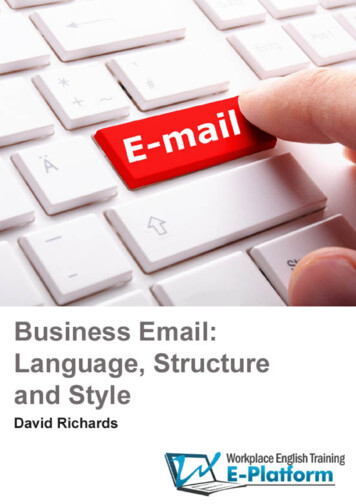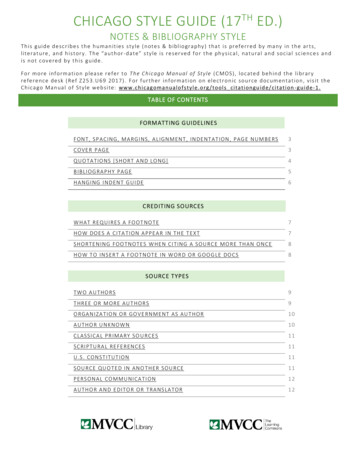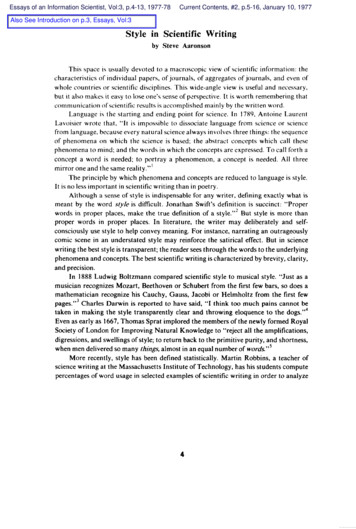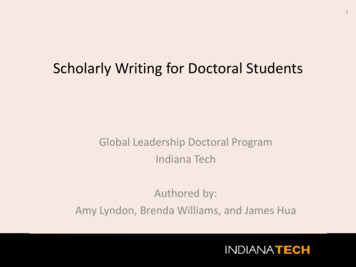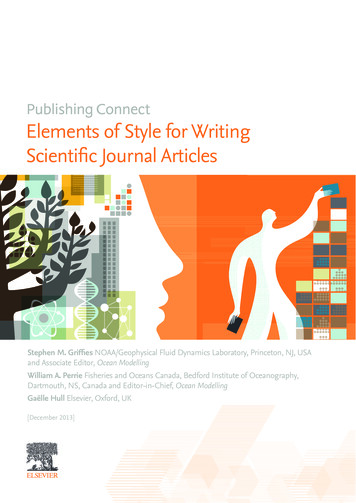
Transcription
Elements of Style for WritingScientific Journal ArticlesStephen M. Griffies NOAA/Geophysical Fluid Dynamics Laboratory, Princeton, NJ, USAand Associate Editor, Ocean ModellingWilliam A. Perrie Fisheries and Oceans Canada, Bedford Institute of Oceanography,Dartmouth, NS, Canada and Editor-in-Chief, Ocean ModellingGaëlle Hull Elsevier, Oxford, UK[December 2013]
ContentsIntroductionWhy you cannot ignore manuscript languageSection IBasic rules of manuscript languageSection IIClassic errors to avoidSection IIIAlways remember your readersSection IVCross-references and figure captionsSection VWriting and rewriting: Playing the peer-review “game”About this document We offer some rules for writing scientific journal articles. We focus less on the structure of an article, and moreon styles and practices helping transfer scientificinformation, ideas, and understanding from the authorto reader. Some material is borrowed from the classic Elements ofStyle by Strunk and White (1918, available athttp://en.wikisource.org/wiki/The Elements of Style)supplemented by experience from Editors of the journalOcean Modelling. Further material is borrowed from the essay: TheScience of Scientific Writing by Gopen and Swan,published in American Scientist in 1990. It is freelyavailable at ience- of-scientific-writing.We thank the following people for many useful commentsand suggestions on drafts of this document:Venkatramani Balaji, Maria Benito-Herrero, CarolinaDufour, Blair Greenan, Bill Li, Joe Majkut and Liuqian YuThe most important ruleWrite for the busy reader who is easilydistracted. Most readers have little time to penetratethe full contents of an article. Readers will use almost any excuse toput down the paper, particularly whenencountering poor writing that leads toreader fatigue and frustration. Make each sentence, paragraph,subsection, section, figure, derivation, etc.coherent and easily digestible nuggets ofinformation. Your job as a writer is to communicateinformation and knowledge in acompelling and well written manner.
INTRODUCTIONWhy you cannot ignoremanuscript languageWhy is language important?Poor language quality can delay or block publication.It is important to take seriously the presentation of your manuscript, especially thelanguage you use to communicate results. Clarity in writing reflects on clarity inthought. Science is far more than mere fact recording. Written communication is keyto transmitting knowledge and rendering an impact on the field.Without clear and proper language, readers will not grasp the full message or impact ofyour work. Even though the findings you report might be cutting edge, poor languagequality, including errors in grammar, spelling or language usage, could delaypublication or lead to outright rejection of the paper.Always use proper English.Use proper English throughout the entire manuscript, and do not forget the captionsand headings in figures, charts, graphs, and photos.Do publishers correct language?No; it is the author's responsibility but resources are available.Often authors assume that the publisher will correct the language of their manuscriptafter it has been accepted, but this assumption is not correct. It is actually the author'sresponsibility to make sure a paper is in the best form possible.Doing so means correcting the rudimentary issues related to grammar and spelling, aswell as providing a clear, logical, and connected story-line.Though publishers do not correct language, they do often provide resources forauthors who are less familiar with the conventions of international journals. Pleasecheck your publisher's Guide for Authors website for more information.Some publishers may also perform technical screening prior to peer review. If thequality of the language of your paper does not meet a journal's minimum standards, itcan be returned to you for improvement.Elements of Style for Writing Scientific Journal Articles3
SECTION IBasic rules of manuscript languageManuscript language: overviewManuscript language should be: Accurate Concise Clear ObjectivePrevent spelling errors by using a spellchecker in English. Additionally, other commonlanguage errors involve: TensesGrammar SentencesParagraphsYou should always read the journal's Guide for Authors to check for any additional languagespecifications.Manuscript language: tensesTake care to use the proper tenses when describing your work and findings. Being consistentand correct in your use of tenses makes your paper easier to understand.Present tense:Use the present tense for known facts and hypotheses, for example, "the average life of ahoney bee IS 6 weeks."Past tense:Use the past tense for describing experiments that have been conducted and the results ofthese experiments, for example "The average life span of bees in our contained environmentWAS 8 weeks "Remember:Avoid shifting tenses within a unit of text: paragraph, sub-section or section.Manuscript language: grammarUse the active voice to shorten sentences.The passive voice can be used in the Methods section of a paper but otherwise, the activevoice will usually shorten sentences and make them more dynamic and interesting for thereader.Use the active phrase "we found that " freely, which is a quick signal to the reader that you aredescribing one of your results. This expression is also much more concise and to the point thanwriting in the passive voice, as in, for example, "it has been found that there had been "Elements of Style for Writing Scientific Journal Articles4
Avoid abbreviations and acronyms.Avoid contractions such as "it's", "isn't", or "weren't" which are not often used in professional writing.Avoid abbreviations/acronyms except for very well-known ones.Avoid acronyms as replacement for citations. Avoid acronyms in the abstract and conclusion. Eliminate redundant words or phrases.due to the fact that because or since immediately apparent apparent in the case that in case and also andin order to determine to determine to try and determine to determine Double-check unfamiliar words or phrases.Manuscript language: sentencesTo write a successful manuscript, first be aware of the sentence structure you use.Write direct and short sentences.The average length of sentences in scientific writing is only about 12-17 words.Include only one piece of information per sentence.Sentences should be constructed in short, factual bursts. Long and complicated sentencestend to confuse readers.Avoid making multiple statements in one sentence.Convey only a single idea per sentence. Link sentences together within a paragraph toprovide a clear story-line.Keep related words together.Closely place the subject and verb to allow the reader to understand what the subject isdoing.Pay attention to the order in which you write a sentence.The "stress position" within a sentence contains new information to be emphasized. The"topical position" contains "old" information leading up to the point of emphasis. The topicalposition comes before the stress position.Avoid: "This ocean basin was warmer during 2012 than any period found in the observationaldatabase, based on our analysis of recent ship-based measurements."Write: "Based on our analysis of recent ship-based measurements, this ocean basin waswarmer during 2012 than any period found in the observational database."Put statements in a positive form. Positive: "He usually came late."Negative: "He is not very often on time."Elements of Style for Writing Scientific Journal Articles5
Manuscript language: paragraphsHave one paragraph for each distinct topic.Begin a paragraph with a topic sentence, andend in conformity with the beginning. Avoid a succession of loose sentences. Parallel structures are simpler to parse as areader. Retain consistent tenses within eachparagraph. Provide a logical transition from oneparagraph to another to render a clear flow,thus guiding the reader from one topic toanother. Paragraphs are similarly constructed tosentences, bringing the reader from the"familiar" at the start to new ideas towards theend. Fill logical holes empathizing with a smartreader who genuinely wants to understandthe flow of ideas. 6
SECTION IIClassic errors to avoidAvoid using "this" unqualified.Avoid: "We found this to be the most important facet of theocean's dynamical response."Write: "We found this feature of the thermocline to be the mostimportant facet of the ocean's dynamical response."What does "this" refer to? If the reader must guess, then theguess could be wrong. Even when it is "obvious" what "this", "that", "these", or "those"refer to, the author serves the reader well by clearly qualifying. Avoid too many successive prepositional phrases.Avoid: "We ran a model simulation of the ocean for research intothe evolution of the thermocline."Write: "We ran an ocean model simulation to conduct researchinto thermocline evolution." Run-on prepositional phrases are awkward to read.They can rapidly lead to reader fatigue.Avoid subjective or redundant words or phrases thatwill date the paper."high resolution""new result" "latest finding" Avoid subjective or judgmental adjectives.Avoid: "We use a simple model of the ocean's thermocline todescribe the dynamical response."Write: "We use an idealized model of the ocean's thermoclinebased on approximating the continuous stratification with twoimmiscible fluid layers to describe the dynamical response.""Simple" has meaning to the reader only when the authorsexplain the opposite "complex" or "realistic" or "complete". Readers should not be asked to read the mind of the authors,nor to share the authors' opinion. Elements of Style for Writing Scientific Journal Articles7
Avoid expressions of belief.Avoid: "We believe this model result to be true."Write: "We show through our analysis that this model result is consistent with the empiricalevidence." Communication of science is not about conveying belief.Rather, it is about logically developing lines of evidence that lead one to a hypothesis,theory, or conclusion based on the evidence.Avoid loose statements and back to back adverbs.Avoid: "The ocean model simulation ran quickly and cheaply."Write: "The ocean model simulation required 1200 hours using 100 computer processors." What is "quickly" and "cheaply"?Elements of Style for Writing Scientific Journal Articles8
SECTION IIIAlways remember your readerAbstract: the key points The abstract provides a concise summary of the key aims and results.If it is not clear and interesting, readers often will read no further.What am I about to read?The introductionThe introduction should lay the ground-work for why the paper is worth reading, anddescribe where the work fits within the existing literature. Introduce the novel elements of the paper in the introduction, thus providing motivationfor the reader to penetrate the main text. Do not over-burden the reader by making the introduction too long. Get to the key parts ofthe paper sooner rather than later. What did I just read?The discussion and conclusion Readers need to know what they have read and why it was significant.Remind the reader why this paper was worth reading and publishing.Concluding sections also provide a venue to set the stage for future research directions.Elements of Style for Writing Scientific Journal Articles9
SECTION IVCross-references and figure captionsThorough cross-referencing Cross-reference equations, figures, and sections both by their number and by their name.Lorem ipsum dolor sit amet,consectetur adipiscing elit.Morbi varius porttitor metus.as seen in the continuityequation (12).Lorem ipsum dolor sit amet,consectetur adipiscing elit.Morbi varius porttitor metus.as seen in equation (12).Lorem ipsum dolor sit amet,consectetur adipiscing elit.Morbi varius porttitor metus.as shown in the transporttime series in Fig. 13.Lorem ipsum dolor sit amet,consectetur adipiscing elit.Morbi varius porttitor metus.as shown in Fig. 13.Lorem ipsum dolor sit amet, consectetur adipiscing elit.Pellentesque ut feugiat eros, at mollis ex. Donec porttitormattis varius .as discussed in the methods Section 2.Pellentesque ultricies aliquet felis vitae feugiat. Lorem ipsum dolor sit amet, consectetur adipiscing elit.Pellentesque ut feugiat eros, at mollis ex. Donec porttitormattis varius .as discussed in Section 2. Pellentesqueultricies aliquet felis vitae feugiat.Asking the reader to page back in the text intensifies reader fatigue.Put your head in the reader's head to determine when it is useful to provide "handholding" in a discussion or a derivation, whereby you identify useful cross-referencing.Figures and captionsFigures can be the most important part of a paper. Produce clear and high qualityfigures along with thorough captions.Avoid excessive numbers of figures: judiciously select those figures that clearly support thepresentation. Allow the reader to digest a figure's main points without reading the text. Produce high quality figures, even on the first submission! When available, embed figures within main text of the submitted manuscript to avoidreviewers needing to page back/forth, which in turn breaks the reading.Elements of Style for Writing Scientific Journal Articles10
SECTION VWriting & rewriting - playing thepeer-review "game"Extensive fine-tuningWrite science as E. Hemingway wrote his literature. Scientists are storytellers too!"My aim is to put down on paper what I see and whatI feel in the best and simplest way."E. HemingwayCan you identify the beginning, middle, and end?What is the "take home message" or "iconic figure" of your paper? Be aware of each word forming a sentence; each sentence forming a paragraph, eachparagraph forming a section Edit Read Edit Read Edit etc.Consider the manuscript from a different perspective between each Edit Read cycle:e.g., read in a different location; read it as an interested and smart non-expert.Patience will reduce time with reviewers/editors, and will enhance the paper'sreadability and impact. Solicit "friendly" reviewer comments from colleagues, and be sure co-authors haveread the manuscript. Ask readers to comment on the "style" of the manuscript as wellas the substance. Writing rules can be selectively broken without sacrificing clarity. But it is important toknow and to respect the rules so to understand when they are usefully broken. Honestly deal with mistakes.There are times when the reviewer (or the author!) identifies a significantproblem/mistake during the review process.Mistakes are embarrassing. But they are far more embarrassing if published! So bethankful the mistake was found during review. If the basis for the paper is undermined by a mistake, then do not try to justifypublishing. There may be another path towards a publishable story. Avoid publishing an incomplete or half-baked story. Readers will be reticent to readyour next paper. Quality over quantity is the ideal. Elements of Style for Writing Scientific Journal Articles11
And finally: Do not give up if you believe in your work.Reviewers are generally not as knowledgeable on the subject of the manuscript as theauthor. Some influential papers that break new scientific ground may be rejected merelybecause reviewers do not appreciate the results. Be patient and persistent. Nonetheless, reviewer comments are almost always useful, even if they are wrong! Some critical or wrong reviewer comments result from poor writing that leads toreviewer misunderstanding and reviewer frustration. Rethink your writing. Let comments sit, especially negative or harsh comments. A poorly written rebuttalcan lead to needless (and sometimes emotional) correspondence with the editor andreviewer.
Clarity in writing reflects on clarity in thought. Science is far more than mere fact recording. Written communication is key . Elements of Style for Writing Scientific Journal Articles 10 Thorough cross-referencing Cross-reference equations, figu

